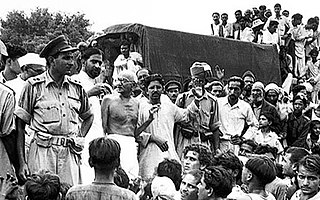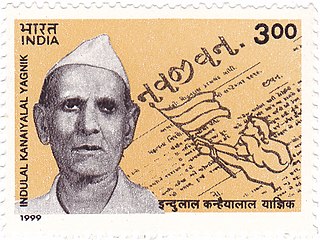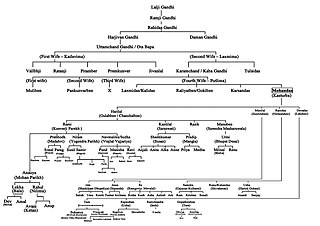Related Research Articles

Mohandas Karamchand Gandhi was an Indian lawyer, anti-colonial nationalist and political ethicist who employed nonviolent resistance to lead the successful campaign for India's independence from British rule. He inspired movements for civil rights and freedom across the world. The honorific Mahātmā, first applied to him in South Africa in 1914, is now used throughout the world.

Satyāgraha, or "holding firmly to truth", or "truth force", is a particular form of nonviolent resistance or civil resistance. Someone who practises satyagraha is a satyagrahi.

Mahadev Haribhai Desai was an Indian independence activist, scholar and writer best remembered as Mahatma Gandhi's personal secretary. He has variously been described as "Gandhi's Boswell, a Plato to Gandhi's Socrates, as well as an Ānanda to Gandhi's Buddha".

The Salt march, also known as the Salt Satyagraha, Dandi March, and the Dandi Satyagraha, was an act of nonviolent civil disobedience in colonial India, led by Mahatma Gandhi. The 24-day march lasted from 12 March 1930 to 5 April 1930 as a direct action campaign of tax resistance and nonviolent protest against the British salt monopoly. Another reason for this march was that the Civil Disobedience Movement needed a strong inauguration that would inspire more people to follow Gandhi's example. Gandhi started this march with 78 of his trusted volunteers. The march spanned 387 kilometres (240 mi), from Sabarmati Ashram to Dandi, which was called Navsari at that time. Growing numbers of Indians joined them along the way. When Gandhi broke the British Raj salt laws at 8:30 am on 6 April 1930, it sparked large-scale acts of civil disobedience against the salt laws by millions of Indians.

Kasturbai Mohandas Gandhi was an Indian political activist who was involved in the Indian independence movement during British India. She was married to Mohandas Gandhi, commonly known as Mahatma Gandhi. National Safe Motherhood Day is observed in India annually on April 11, coinciding with Kasturba's birthday.

The Anarchical and Revolutionary Crimes Act of 1919, popularly known as the Rowlatt Act, was a law, applied during the British India period. It was a legislative council act passed by the Imperial Legislative Council in Delhi on 18 March 1919, indefinitely extending the emergency measures of preventive indefinite detention, imprisonment without trial and judicial review enacted in the Defence of India Act 1915 during the First World War. It was enacted in the light of a perceived threat from revolutionary nationalists of re-engaging in similar conspiracies as had occurred during the war which the Government felt the lapse of the Defence of India Act would enable.

Manilal Mohandas Gandhi was the second son of Mahatma Gandhi and Kasturba Gandhi.

Potti Sreeramulu, was an Indian freedom fighter and revolutionary. Sreeramulu is revered as Amarajeevi in the Andhra region for his self-sacrifice for the Andhra cause. He became famous for undertaking a hunger strike for 56 days in support of having separate state for Andhra Pradesh; he died in the process. His death sparked public rioting and Indian Prime Minister Jawaharlal Nehru declared the intent by the newly liberated nation to form Andhra State three days following the death of Sreeramulu. He contributed his life for the formation of a separate Telugu-speaking state from the dominant Tamil-speaking Madras presidency. His struggles led to the formation of separate Telugu-speaking state called "Andhra state".

Kanhaiyalal Maneklal Munshi, popularly known by his pen name Ghanshyam Vyas, was an Indian independence movement activist, politician, writer from Gujarat state. A lawyer by profession, he later turned to author and politician. He is a well-known name in Gujarati literature. He founded Bharatiya Vidya Bhavan, an educational trust, in 1938.

Abbas Tyabji was an Indian freedom fighter from Gujarat, and an associate of Mahatma Gandhi. He also served as the Chief Justice of Baroda State. His grandson is historian Irfan Habib.

The Champaran Satyagraha of 1917 was the first satyagraha movement led by Mahatma Gandhi in British India and is considered a historically important rebellion in the Indian independence movement. It was a farmer's uprising that took place in Champaran district of Bihar in the Indian subcontinent, during the British colonial period. The farmers were protesting against having to grow indigo with barely any payment for it.

Mahatma Gandhi Museum was formerly Alfred High School in Rajkot was one of the oldest educational institutions in India which was active for 164 years where Mahatma Gandhi studied few years.

Hermann Kallenbach was a Lithuanian-born Jewish South African architect who was one of the foremost friends and associates of Mahatma Gandhi. Kallenbach was introduced to the young Mohandas Gandhi while they were both working in South Africa and, after a series of discussions, they developed a long-lasting association.
Dinanath Gopal Tendulkar (1909–1972) was an Indian writer and documentary film maker. He is most well known as the author of an eight-volume biography of Mahatma Gandhi, titled Mahatma: Life of Mohandas Karamchand Gandhi. He was also a close associate of Vithalbhai Jhaveri and collaborated for the documentary film, Mahatma: Life of Gandhi, 1869–1948. He died on Monday, June 12, 1972.

Indulal Kanaiyalal Yagnik was an Indian independence activist, who purchased indian tri colour flag from Germany to India. He was a leader of the All India Kisan Sabha and one who led the Mahagujarat Movement, which spearheaded the demand for the separate statehood of Gujarat on 8 August 1956. He is also known as Indu Chacha. He was also a writer and film maker.

Kushal Konwar was an Indian freedom fighter from Assam. He was hanged in 1942 during the Quit India Movement.
Swami Anand was a monk, a Gandhian activist and a Gujarati writer from India. He was the manager of Gandhi's publications such as Navajivan and Young India and inspired Gandhi to write his autobiography, The Story of My Experiments with Truth. He wrote sketches, memoir, biographies, philosophy, travelogues and translated some works.
Kanu Gandhi was an Indian photographer. He was a grandnephew of Mahatma Gandhi who lived with him in several of his ashrams and was a member of his personal staff. He is best remembered as Gandhi's photographer, recording many moments of Gandhi's life on film from 1938 until his assassination in 1948. Following Gandhi's death, Kanu and his wife Abha moved to Rajkot where they ran a rural centre named after Kasturba Gandhi. Abha was one of the companions with Gandhi at Birla House Delhi, when Godse shot Gandhi.

The Gandhi family is the family of Mohandas Karamchand Gandhi, commonly known as Mahatma Gandhi; Mahatma meaning "high souled" or "venerable" in Sanskrit; the particular term 'Mahatma' was accorded Mohandas Gandhi for the first time while he was still in South Africa, and not commonly heard as titular for any other civil figure even of similarly rarefied stature or living or posthumous presence.

The Kheda Satyagraha of 1918 was a satyagraha movement in the Kheda district of Gujarat in India organised by Mahatma Gandhi during the period of the British Raj. It was a major revolt in the Indian independence movement. It was the second Satyagraha movement, which was launched 7 days after the Ahmedabad mill strike. After the successful Satyagraha conducted at Champaran in Bihar, Gandhi organised the movement to support peasants who were unable to pay the revenue because of famine and plague epidemic.
References
- ↑ "National hunger strike?". Gulf Daily News . 9 June 2011. Retrieved 27 January 2012.
- ↑ "Letter to Millie Graham Polak, July 13, 1913" (PDF).
- 1 2 3 4 5 6 7 8 O.P. Dhiman (2010). Betrayal of Gandhi. ISBN 978-81-78-35-746-1.
- ↑ Hunt, James D. (2005). An American looks at Gandhi : essays in satyagraha, civil rights, and peace. New Delhi: Promilla & Co. Publishers, in association with Bibliophile South Asia. p. 32. ISBN 81-85002-35-5. OCLC 61170051.
- ↑ "Letter to Raojibhai Patel, footnote 1, After February 15, 1914" (PDF).
- ↑ "Letter to Elizabeth Mari Molteno, May 19, 1914" (PDF).
- ↑ Jack, Homer A. (2005). "Short Chronology of Gandhi's Life". Mahatma.com. Worldview.com. Archived from the original on 23 October 2005. Retrieved 27 January 2012.
- ↑ The Bombay Chronicle, 22 November 1921. The Bombay Chronicle (Bombay). 1921-11-22.
- ↑ The Bombay Chronicle, 23 November 1921. The Bombay Chronicle (Bombay). 1921-11-23.
- 1 2 "The Previous Fasts". The Indian Express . 4 March 1943. Retrieved 27 January 2012.
- ↑ Pyarelal (1932). "The Epic Fast" (PDF).
- 1 2 "Mohandas K. Gandhi: The Indian Leader at Home and Abroad". New York Times . 31 January 1948. Retrieved 30 December 2013.
- ↑ Rajmohan Gandhi (10 March 2008). Gandhi: The Man, His People, and the Empire. p. 361. ISBN 978-0-520-25570-8.
- ↑ "Rajkot dispute settled - Gandhi breaks his fast". The Advocate. 8 March 1939.
- ↑ theg; Higuyin #g; Ago, Hi • 4 Years (2019-03-03). "Gandhi's flawed fast - 99 hours in Rajkot". Steemit. Retrieved 2023-01-13.
{{cite web}}: CS1 maint: numeric names: authors list (link) - ↑ "Anna a man of stamina, his longest fast lasted 12 days". Daily News and Analysis . 24 August 2011. Retrieved 27 January 2012.
- ↑ "Gandhiji Breaks Fast". The Indian Express . 4 March 1943. Retrieved 30 December 2013.
- ↑ "Gandhi's last (And greatest) fast". 31 August 2018.
- ↑ "Gandhi's last (And greatest) fast". 31 August 2018.